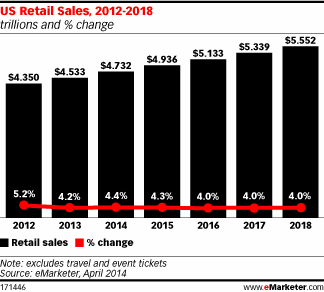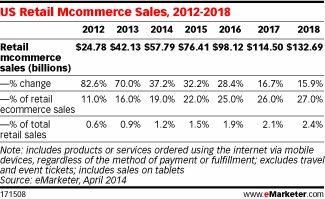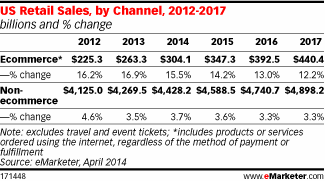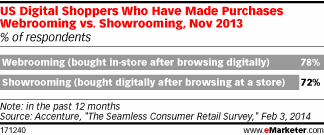
eMarketer recently released it’s first ever forecast for total U.S. retail and retail store sales and the results are surprising – if you’re a ‘mobile first’ advocate. Though U.S. total retails sales are projected to grow to $5.5 trillion by 2018, mobile commerce, or mcommerce, is only set to grow to 2.4% of total retail sales in 2018.

The study ‘separates retail ecommerce sales – including all purchases made from desktop and laptop computer, tablets and mobile phones – and nonecommerce sales, which mostly comprise brick-and-mortar retail purchases.’ While ecommerce sales are set to grow to 9% of total retail sales by 2018, mcommerce still only comprises 27% of the ecommerce projection. In other words, by 2018, ecommerce sales driven by PC and laptops will be an approximate $359 billion dollar sales channel while mcommerce sales (driven by smartphones and tablets) will only be an approximate $132.69 billion dollar sales channel.

This study contradicts other studies such as the Juniper Research study that found mcommerce sales would reach $707 billion by 2018. So which projection is right? Likely both and likely somewhere in the middle. eMarketer also cites in their report that tablets will comprise over 75% of mcommerce sales. The smartphone-based mcommerce experience has not quite caught on yet with U.S. shoppers based on additional studies. When looking at apparel and clothing purchases, a report from Experian found that “approximately half of PC and tablet owners have purchased clothing and accessories on their devices, compared to just 28% of mobile phone users.” IBM’s Black Friday Report from 2013, also reaffirms the Experian study with data showing that smartphone-based purchases only drove 7.2% of all online sales.
Though smartphone driven mcommerce is still an extremely small piece of the retail sales pie, mobile has become an integral part of an omnichannel retail strategy with respect to how mobile is utilized in-store. In a recent blog post, we looked at the Motorola Shopping Study and which technologies shoppers thought would influence their purchase decisions. Though we focused on Intelligent Dressing Rooms and Interactive Mirrors in the post, a consumer’s mobile device would be integral to any type of Virtual Dressing Room experience in-store. This same study also shows how loyalty account access and comparison shopping would also influence a shoppers experience.
An additional eMarketer report citing an Accenture Consumer Retail Study highlights how showrooming and webrooming (i.e. reverse showrooming) are already utilized by a majority of shoppers. With the ‘reverse showrooming‘ trend increasing with younger shoppers, web and mobile technologies are both helping to drive shoppers in-store to purchase. As an example, 22% of polled US consumers said that mobile had increased their retail store trips. There is an incredible opportunity here for retailers to tap into these pre-qualified shoppers by utilizing technologies that can further influence their purchase decision in-store.

With regards to an integrated mobile and in-store purchase, there are questions to how that purchase is defined as well. If a shopper is using technologies such as Beacon and initiates the purchase via their mobile device but finalizes their purchase on a POS device or display, is that categorized as an in-store purchase or a mobile purchase? As shoppers increasingly use their mobile devices while shopping in-store, this mobile-to-device integration further blurs the line between a channel specific sale.
Another eMarketer study sought to find which mobile based tools shoppers thought would be helpful when shopping for CPG products. It wasn’t surprising to see Augmented Reality at the top of the list. However, Augmented Reality is not currently a primary technology for purchasing, but rather a technology used for engagement to influence and lead to the purchase conversion. It’s not clear yet how these mobile tools are directly or indirectly accounting for a sale within a specific sales channel.
Regardless of where you fall on the accuracy of ecommerce or mcommerce projections, what cannot be denied is how large of a market in-store and offline retail still is and will be for the near future. With the in-store retail experience evolving, retailers will need to adapt and leverage different technologies shoppers are utilizing that directly or indirectly influence their purchase decision. Though the mcommerce direct sales channel projects to be a small percent of overall ecommerce sales, the mobile influence in-store will be critical for retailers to embrace – both for their own sales associates and shoppers.
MAY
